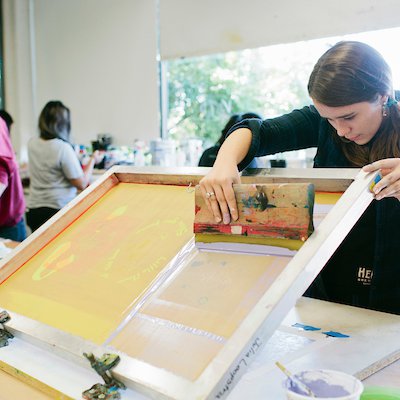The Necessary Overview to Comprehending Screen Printing and Its Versatile Utilizes
Screen printing has an abundant history that dates back to old times, developing right into an advanced method utilized throughout different industries today. This overview checks out the complexities of the screen printing process, detailing its applications in home, advertising and marketing, and fashion décor - 10:9 Design Screen Printing Texas. Comprehending these principles can open creative capacity for both industrial and artistic tasks. The complying with areas will certainly reveal essential suggestions and strategies to boost one's screen printing endeavors
The History of Screen Printing
Screen printing has origins that map back centuries, its development reflects the imaginative and technological developments of different societies. Coming from ancient China, the method was originally made use of for enhancing fabrics and later infect Japan, where it came to be integral to Ukiyo-e woodblock printing. The method moved to Europe in the 18th century, where it got appeal amongst artisans and industrial printers. The creation of picture solution in the 20th century changed screen printing, permitting even more complex layouts and higher effectiveness. Musicians like Andy Warhol additionally thrust its appeal, utilizing the medium to create iconic works that blended commercialism and art. By the late 20th century, screen printing had actually developed itself as a flexible technique, employed in vogue, advertising, and great art. Today, it proceeds to progress, integrating digital modern technology and increasing its applications throughout different industries.
The Screen Printing Refine Explained
Screen printing changes creative visions into substantial styles with a series of specific steps. Initially, a photo is produced and after that transferred onto a screen, typically constructed from fine mesh material extended over a framework. A light-sensitive emulsion is put on the screen, which is subjected to light, hardening in locations not covered by the photo. After cleaning out the unhardened emulsion, a pattern is developed.
Next off, the screen is put over the substratum, whether it be material, paper, or another material. Ink is after that pressed through the open areas of the pattern utilizing a squeegee, transferring the design onto the substratum below. This procedure can be repeated for several shades, needing different screens for every shade. The printed product is healed using warm to assure the ink adheres correctly, resulting in a sturdy, lively design prepared for usage.
Kinds Of Screen Printing Techniques

Additionally, specialty methods, such as discharge screen printing, remove color from the material to create softer prints, while foil screen printing applies metallic aluminum foil to achieve a shiny finish (10:9 Design Abilene). Each strategy provides distinctive characteristics, satisfying numerous innovative demands and production ranges, inevitably broadening the opportunities within the screen printing domain name
Applications of Screen Printing in Various Industries

Additionally, the signs and advertising and marketing industries use screen printing for producing appealing screens and banners. This approach permits bold shades and complex layouts that capture find out interest. In electronic devices, screen printing is used for applying conductive inks to motherboard, important for element links. The home décor market welcomes screen printing to generate distinctive designs on textiles and wall surface art. On the whole, screen printing works as an important device throughout diverse areas, improving items with individualized and aesthetically enticing graphics.
Tips for Effective Screen Printing Projects
While undertaking a screen printing project, careful interest to detail can significantly enhance the final outcome. First, choosing high-grade products is essential; this includes the screen, inks, and substratums. Utilizing suitable mesh counts can affect ink deposition and detail resolution. Prep work is similarly crucial; complete cleansing of screens and proper direct exposure times assure crisp prints.
Next off, precise registration is critical for multi-color prints. Making use of placement tools can help achieve specific layering. In addition, testing prints on scrap materials prior to production helps recognize possible problems without throwing away resources.

Regularly Asked Questions
What Materials Are Ideal for Screen Printing on Textile?
Cotton and polyester blends are ideal for screen printing on fabric due to their resilience and ink absorption. Furthermore, specialty textiles like silk or canvas can generate special appearances and surfaces, improving the overall design quality.
Just how Do I Clean and Maintain Screen Printing Tools?
To cleanse and keep screen printing equipment, one need to regularly clean screens with suitable solvents, inspect mops for wear, oil moving parts, and shop all products in a dry, dust-free setting to prolong their life-span.
What Are the Ecological Impacts of Screen Printing?
Screen printing can have significant ecological effects, consisting of chemical waste from solvents and inks, water usage during cleansing processes, and energy intake. Eco-friendly products and sustainable techniques are crucial for lessening these negative results.
Can Screen Printing Be Done in your home Effectively?
Screen printing can be efficiently done at home with the right products and techniques. Enthusiasts can create high quality prints, though success depends on their skill degree, equipment, and understanding of the process included.
What Are the Costs Connected With Beginning a Screen Printing Organization?

Beginning a screen printing business entails prices for equipment, materials, and office. First expenses usually vary from a couple of hundred to numerous thousand dollars, relying on the range, quality of machinery, and preferred production capability.
Screen printing has an abundant background visit our website that dates back to old times, developing into an advanced method utilized throughout numerous sectors today. An additional method, rotating screen printing, utilizes round displays, assisting in continual printing on textile rolls, therefore boosting performance for large-scale productions. Additionally, specialty techniques, such as discharge screen printing, remove color from the textile to develop softer prints, while aluminum foil screen printing uses metal aluminum foil to accomplish a glossy surface. In the fashion sector, screen printing is widely made use of to develop lively styles on clothing, enabling brands to display their one-of-a-kind designs. Cotton and polyester blends are suitable for screen printing on material due to their sturdiness and ink absorption.